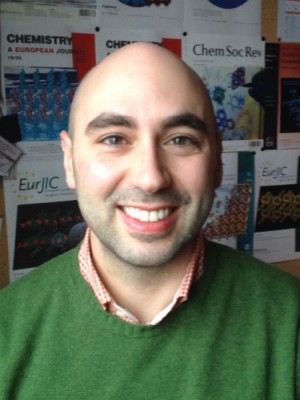abstract
A series of meso-tetraaryl-substituted free-base porphyrins containing different numbers of alkyl amide chains with different lengths, as well as the corresponding palladium(II) and platinum(II) complexes, were prepared in good yields and were fully characterised. The crystal structure of the palladium(II) complex containing eight alkyl chains with five carbon atoms was unequivocally elucidated by means of single-crystal XRD studies. The thermal behaviour of the new compounds was studied by polarised light optical microscopy and differential scanning calorimetry. Porphyrins with eight terminal alkyl chains containing five and eight carbon atoms, and the corresponding palladium(II) complexes, behave as liquid-crystalline materials, exhibiting lamellar columnar mesophases at temperatures above 80 degrees C. The number of terminal alkyl chains and the palladium(II) metal centre play a key role in achieving mesomorphic behaviour.
keywords
TRANSITION-METAL-COMPLEXES; DISCOTIC LIQUID-CRYSTALS; PORPHYRINS; DERIVATIVES; MESOMORPHISM; DESIGN; PHASE
subject category
Chemistry
authors
Moura, NMM; Cuerva, C; Cavaleiro, JAS; Mendes, RF; Paz, FAA; Cano, M; Neves, MGPMS; Lodeiro, C
our authors
acknowledgements
We are grateful to the Universidade de Aveiro, Fundacao para a Ciencia e a Tecnologia (FCT), the European Union, QREN, FEDER and COMPETE for funding the QOPNA research unit (project PEst-C/QUI/UI0062/2013) and CICECO-Aveiro Institute of Materials (Ref. FCT UID/CTM/50011/2013). We acknowledge the Portuguese National NMR Network (RNRMN), supported by funds from FCT, Scientific PROTEOMASS Association (Portugal) and LAQV/REQUIMTE (UID/QUI/50006/2013) and UCIBIO/REQUIMTE (UID/Multi/04378/2013) for general funding. M.C. also thanks the Spanish Ministerio de Economia y Competitividad (project CTQ2011-25172) and Complutense University (GR3/14-910300), for funding. N.M.M.M. thanks the FCT/MEC for his post-doctoral grant no. SFRH/BPD/84216/2012 and R.F.M. for his doctoral research grant no. SFRH/BD/84231/2012. C.C. is grateful to the Programa de Financiacion de Universidad Complutense de Madrid-Santander Universidades (Spain), for his pre-doctoral grant. Finally, we thank Dr. Jose A. Campo for his help with the TG and DSC studies.



